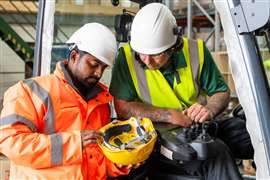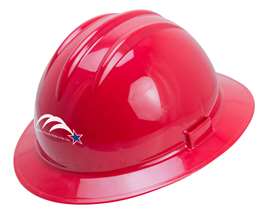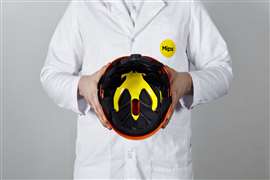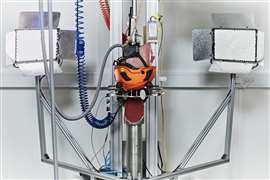How long should a hard hat last?
26 September 2023
 Image: Tony Pick Photography
Image: Tony Pick Photography
A hard hat is such a ubiquitous item of personal protective equipment (PPE) in construction that it has become emblematic of safety in the industry.
Worn by generations of construction workers, hard hats play an important role in protecting against the risk of head injuries and are mandatory in many countries around the world.
But how long should a hard hat last, and under what circumstances should they be replaced?
“When it comes to hard hats, there is no set standard, but governing bodies like OSHA (The Occupational Safety and Health Administration) and the HSE (Health and Safety Executive) have PPE guidance and regulations,” says Chris Tidy, product specialist for Mips and founder of Hard Hat Awareness Week in the UK.
“This type of regulation exists in other countries and does not vary much from one to another. These regulations usually require employers to provide PPE to employees exposed to risks and hazards that can cause severe injury or illness. Employers must ensure that PPE is maintained, clean, sanitary, and replaced when damaged, contaminated, or no longer provides the necessary protection.”
Manufacturers offer advice on when hard hats should be replaced, but the major international safety standards that set the minimum performance requirements for hard hats don’t set out any explicit time limits, adds Matt King, global product portfolio manager, head & face protection at hard hat manufacturer Bullard, based in Kentucky, USA.
“Currently, the major standards I’m aware of such as ANSI/ISEA Z89.1 and EN 397 have no provisions for any replacement timeline,” King says.
 A construction hard hat manufactured by Bullard (Image: Bullard)
A construction hard hat manufactured by Bullard (Image: Bullard)
He points out that there are two different but related concepts to keep in mind: service life and shelf life.
Shelf life refers to a hard hat or helmet that hasn’t been used and has been stored in a cool, dark area. Crucially, it must not have been exposed to anything that could cause it to degrade, such as ultraviolet (UV) rays, fluctuations in temperature, or chemicals.
Most manufacturers will claim anywhere from five to ten years of shelf life but the service life is different.
“The service life of a helmet varies depending on the environment in which it is used so this is why standards often don’t prescribe any given time,” says King.
“For instance, a helmet that is used in a hot, sunny environment, like a desert, for several hours a day has substantial UV exposure and thus will not last as long as one a supervisor wears in an air-conditioned indoor environment.”
To account for the variation in conditions, most manufacturers state that a hard hat should be replaced at a minimum of five years.
If it has a suspension system within it, that should be replaced every year.
Meanwhile, some companies create their own replacement schedules depending on the different hazards hard hats are exposed to.
“The one thing every manufacturer will agree on is that any time a helmet or hard hat has been impacted or shows any sign of degradation in the shell or impact system it should be replaced immediately,” King adds.
Inspection is key
Another determinant for the service life of a hard hat is the materials it is made from.
 Image: Mips
Image: Mips
Typically, the past few decades have seen hard hats made from a combination of thermoplastics in the shell and nylon straps or expanded polystyrene (EPS) foam liners for the impact systems.
Tidy says, “Little research has gone into how long hard hats last during typical use once the polymer has been moulded or thermoplastic injected. Hard hats have expiry dates, which may be shortened if the wearer has long-term exposure to certain hazards or cut short if a hard hat receives a significant impact.
He emphasises, “The key is regular inspection, assessment of the risks and consultation with suppliers to determine the longevity of the hard hat.”
That inspection extends to technology like Mips’ own safety system. While low-friction layers like Mips, designed to help reduce rotational force to the head during certain angled impacts, are mounted into construction helmets during production should last the lifecycle of the hard hat itself, it does also need checking, says Tidy.
“During the regular inspection of a hard hat, any attached accessories or safety systems like Mips should also be included,” he says.
“Look for signs of wear and tear or parts that may be damaged and replace these or the entire hard hat, depending on the model. It is essential not to leave anything to chance, as poor checking and assessing safety equipment may have consequences.”
Materials can prolong service life
All materials will degrade at a certain rate when exposed to extreme environments but there are various things manufacturers can do to prolong their lives.
Bullard adds UV inhibitors to the high density poly ethylene (HDPE) used to make the shells of its hard hats to slow the effect of UV exposure degradation, for example.
There are also specialized helmets that can withstand high temperatures by using more resilient materials for certain applications.
“Future material science advances will allow for more resilient plastics that still provide the safety workers need in a variety of environments,” says King.
New technologies
There are ways to check how much exposure hard hats have had to UV by buying tools like an after-market sticker. The Uvicator sensor from 3M, for example, is a disc that gradually changes from red to white in a clockwise direction as UV exposure is detected.
There are also new technologies that detect impacts and can help to determine if a hard hat or helmet needs to be replaced.
“More companies are starting to develop impact detection solutions, similar to what an iPhone has through its crash accelerometer. Others have mechanical spring solutions that break at certain forces,” King says.
Such solutions are currently expensive and so adoption in a sector like construction is minimal. Instead they have been largely limited to more expensive sports helmets.
But King adds, “I don’t think a world is far off where these can start to integrate into hard hats and helmets as their cost drops.
“Many large job sites will have connected tools as well, so the platform for further integrated worker health and PPE monitoring could be available.”
Do stickers impact the longevity of a hard hat?
Employees and supervisors quite often apply stickers to hard hats, whether it is to identify the names of workers, display a logo of the company they are working for, or signify certain training or qualifications.
 Image: Mips
Image: Mips
But it has been suggested that the adhesives from these stickers may damage the shell of the helmet, as well as potentially concealing signs of damage.
King says that as far as the potential for adhesives to degrade the hard hat, “it really depends on what the adhesive is.”
“Stickers that are more permanent likely could cause issues,” he adds.
But other types of stickers are fine. “We apply reflective strips to our hats and have no issues,” he says. “I know many customers who apply stickers and no issues arise.”
While manufacturers apply stickers using adhesives that won’t damage hard hats, King acknowledges that users can’t tell which stickers are good or bad because there are so many different adhesives and shell materials which could combine.
“If a customer is wary, it’s always best to be cautious,” he concludes.
Four tips for assessing your hard hat
Chris Tidy stresses that it is important to consult with the manufacturer of the hard hat or a qualified safety professional to determine the specific replacement schedule for the model in question.
They can help you assess the hazards the Hard Hat is designed to protect against and recommend an appropriate replacement schedule.
Tidy also offers four additional tips when it comes to assessing the replacement of your hard hat:
- Inspect the hard hat before each use for signs of damage or contamination
- Replace the hard hat immediately if it is damaged or contaminated
- Store the hard hat in a clean, dry place when not in use
- Dispose of the hard hat properly using one of the recycling schemes available when it is replaced or not required.
STAY CONNECTED



Receive the information you need when you need it through our world-leading magazines, newsletters and daily briefings.
CONNECT WITH THE TEAM








